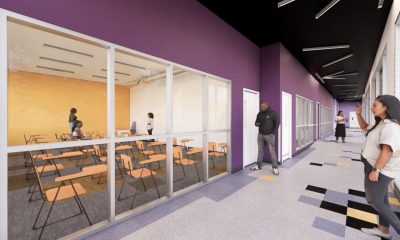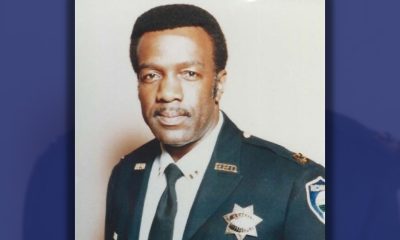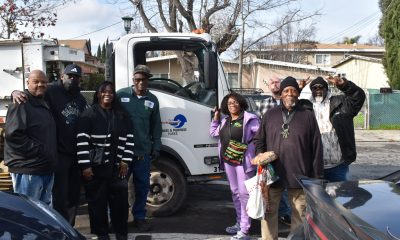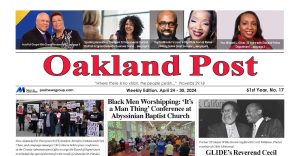Arts and Culture
Día de los Muertos Festivities in Oakland Bring in Crowds of Celebrants
On Oct. 22, the Oakland Museum of California (OMCA) held its annual celebration at 10th and Fallon streets while the Unity Council held a street festival on International Boulevard and Fruitvale Avenue last Sunday. Coinciding with Halloween, Día de los Muertos, or Day of the Dead, dates back to traditions established by the indigenous peoples of America that fused, over time, with the Catholic beliefs brought by Spanish conquistadors.
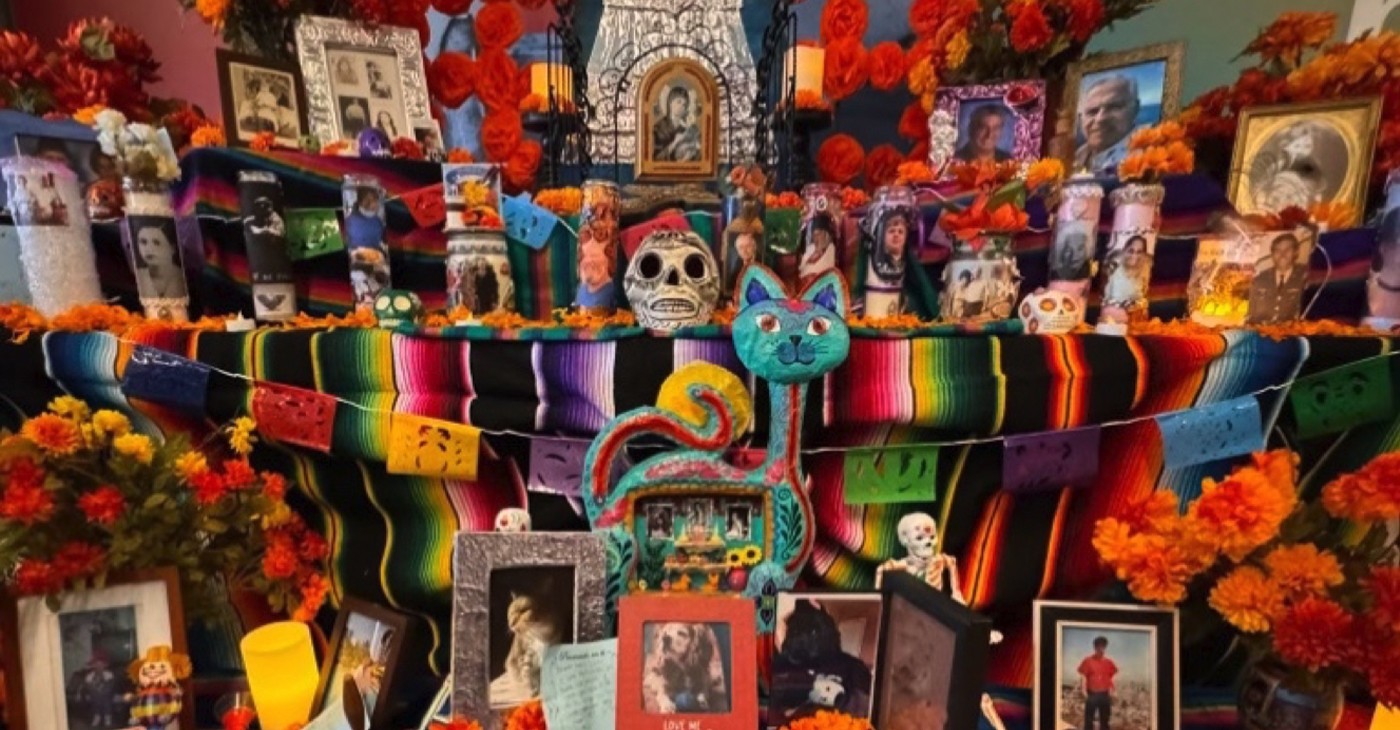
By Eva Ortega and
Magaly Muñoz,
Post Staff
In a haze of incense smoke, flickering candles and bright orange marigolds, Oakland outdid itself with two weekends of Día de los Muertos observances that were both solemn and festive.
On Oct. 22, the Oakland Museum of California (OMCA) held its annual celebration at 10th and Fallon streets while the Unity Council held a street festival on International Boulevard and Fruitvale Avenue last Sunday.
Coinciding with Halloween, Día de los Muertos, or Day of the Dead, dates back to traditions established by the indigenous peoples of America that fused, over time, with the Catholic beliefs brought by Spanish conquistadors.
Though it has primarily Mexican roots, it is also celebrated in parts of Bolivia, Ecuador, Guatemala, and other countries.
Its components are also recognized as part of the Intangible Cultural Heritage of Humanity by the United Nations.
As they performed the ancient dance of the dead, the fragrant smoke of copal wafted over the Ollin Anahuac Traditional Aztec Dance group who were the stars of the opening ceremony at the Oakland Museum’s 29th Annual Día de los Muertos Community Celebration.
Despite wind and light rain, a sizeable crowd came out to view altars created by local groups, including students from Bret Harte Middle School, Richmond High School and Black Girls Excellence from Montera Middle School.
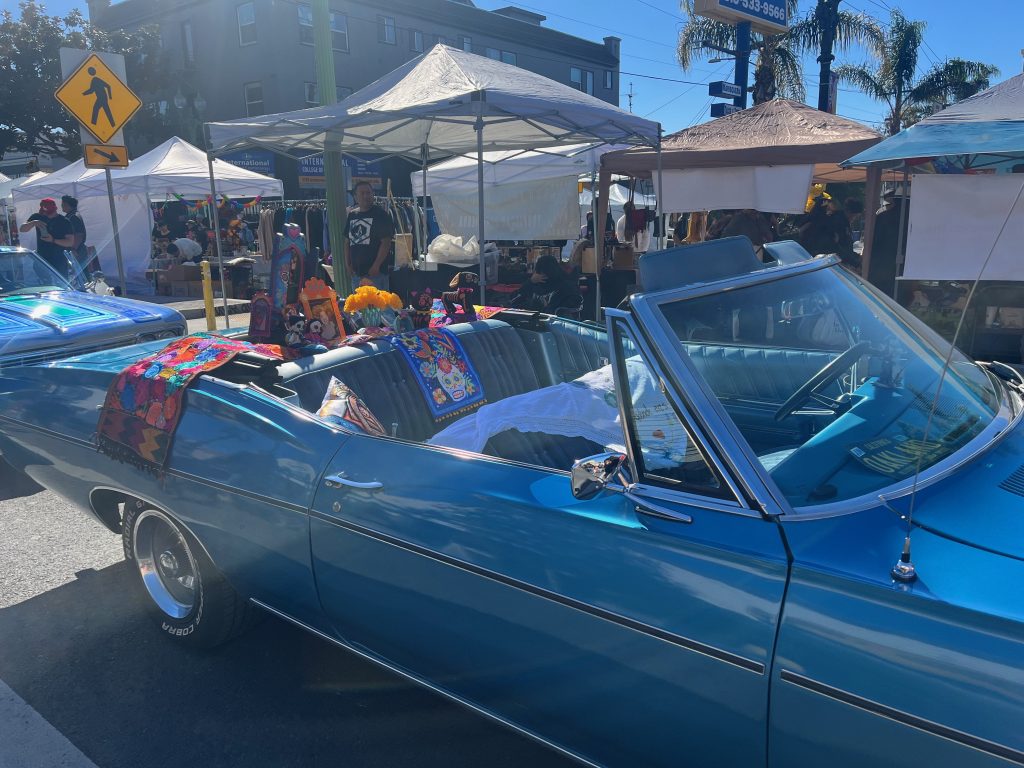
A vintage car becomes the site for an ofrenda at “Blooming Resistance,” the Unity Council’s 28th Día de los Muertos Festival on Oct. 29, 2023. Photo by Magaly Muñoz.
A variety of performances also took place throughout the day, including by award-winning artist Gabriela Sepúlveda and notable poets Tino V. H., Jr., Briana Victoria Leung and Camila Elizabet Aguirre Aguilar.
Aguilar captivated listeners with an emotional performance dedicated to Vanessa Guillen, the 20-year-old army soldier whose 2020 murder sparked protests across the country.
“Oral storytelling is in our blood, and we’ve practiced this for hundreds, thousands of years,” Aguilar said. “When we have youth murdered that are indigenous to this content…women, it is important that we call attention to the powers and structures that cause [violence] and that we continue with the traditions of resistance and honoring the dead.”
While rain had depressed the numbers at the Oakland Museum celebration, the sun was bright on Sunday in the Fruitvale for “Blooming Resistance,” the 28th such Día de los Muertos Festival.
The street was covered with brightly colored streamers and flowers and lined with vendors and informational booths.
Altares with photos and ofrendas could be seen at every corner of the festival. Many had personal notes from family, favorite foods of the deceased loved one and symbols that represent them.
Iliana Vasquez, who was hired by The Unity Council to help organize the event, expected a larger crowd than previous years and hoped to attract more than the usual 100,000 attendees.
“For me, the community is my main focus. I hope they’re there to have a good time with their families,” Vasquez said.
Food vendors crowded the streets, selling tacos, fruit, aguas frescas and most notably pan de muerto or ‘bread of the dead.’ This sweet bread is meant to resemble bones and is a vital part in the offerings used for the altars. It is used to lure souls to visit their loved ones.
Another staple in Día de los Muertos is the cempazúchitl, or marigold flowers that adorn the altars.
Rocio Plate was one of the many vendors who sold the marigolds, but instead of just selling them as a simple bouquet, she fashioned them into crosses and crowns and bunched them up into vases.
Resident Robert Berger says cultural events such as the one at OMCA are what brought him to Oakland almost a decade ago. He and his partner also attend the festival in Fruitvale every year.
“It’s what creates hope for the future amidst a lot of turmoil and it’s really what brought us to Oakland in the first place, being so eclectic, diverse and enriching,” Berger said. “If you don’t participate in them, you’re really missing out on a lot.”
Those who have missed both of Oakland’s Día de los Muertos events can still view OMCA’s “In Remembrance of Our Ancestors” installation that showcases how Día de los Muertos emerged as the holiday many recognize today. It will run until Nov. 26.
Eva Ortega is part of the Community Media journalism class at San Francisco State University.
Arts and Culture
Kedrick Armstrong: New Music Director for the Oakland Symphony
The Oakland Symphony Announced Kedrick Armstrong as its Next Music Director. In addition to conducting the orchestra’s public concerts, Armstrong will also actively participate in the Oakland Symphony’s many education and community engagement programs, designed to inspire a love of music in people of all ages.

By Post Staff
The Oakland Symphony Announced Kedrick Armstrong as its Next Music Director.
In addition to conducting the orchestra’s public concerts, Armstrong will also actively participate in the Oakland Symphony’s many education and community engagement programs, designed to inspire a love of music in people of all ages.
Armstrong is the successor to previous music director and Conductor Michael Morgan, who passed away in 2021 after a 30-year tenure at the Symphony.
Armstrong will open the Oakland Symphony 2024-2025 season on October 18.
Armstrong, who is 29 and hails from Georgetown, South Carolina, is currently the creative partner and principal conductor of the Knox-Galesburg Symphony.
The Chicago Tribune has praised Armstrong for his ability to “simply let the score speak for itself.” He enjoys a wide range of repertoire, spanning early music to premiering new works, using his joy and curiosity for all music to cultivate understanding and collaboration within diverse communities.
“I am deeply honored and grateful for the opportunity to serve as the new music director of the Oakland Symphony,” Armstrong said. “As a Black conductor, I find it humbling to stand on the shoulders of both Michael Morgan and Calvin Simmons,” the most recent and the first African American music directors of the Symphony, respectively.
Armstrong led three programs at the Symphony between 2022 and early 2024, which showcased his broad knowledge of the classical repertoire and enthusiasm for spotlighting diverse voices.
On his Oakland Symphony subscription debut on Feb. 16, Armstrong led the world premiere of “Here I Stand: Paul Robeson,” an oratorio by Carlos Simon on a libretto by Dan Harder, commissioned by the Oakland Symphony.
Armstrong was selected unanimously by the Oakland Symphony’s board of directors and musicians after an extensive two-year search. “The search committee was overwhelmed by Kedrick’s scholarship and curiosity about all kinds of music, from classical and jazz to gospel and hip-hop,” said. Dr. Mieko Hatano, executive director of the Oakland Symphony. “We are thrilled to have him join us at the Oakland Symphony.”
Arts and Culture
Faces Around the Bay Dr. Carl Blake, Pianist
Born in Liberty, Missouri, Carl Blake, a virtuoso and respected pianist, made his most recent migration to the East Bay in 1999. One might have seen him performing recently at Noontime Concerts in San Francisco, or at the Piedmont Center for the Arts in Oakland. He is Director of Music at The Church for the Fellowship of All Peoples in San Francisco. He was also co-organizer and collaborative pianist at Herbst Theater for The Majesty of the Spirituals concert in 2022 and has held several church positions in the Bay Area.
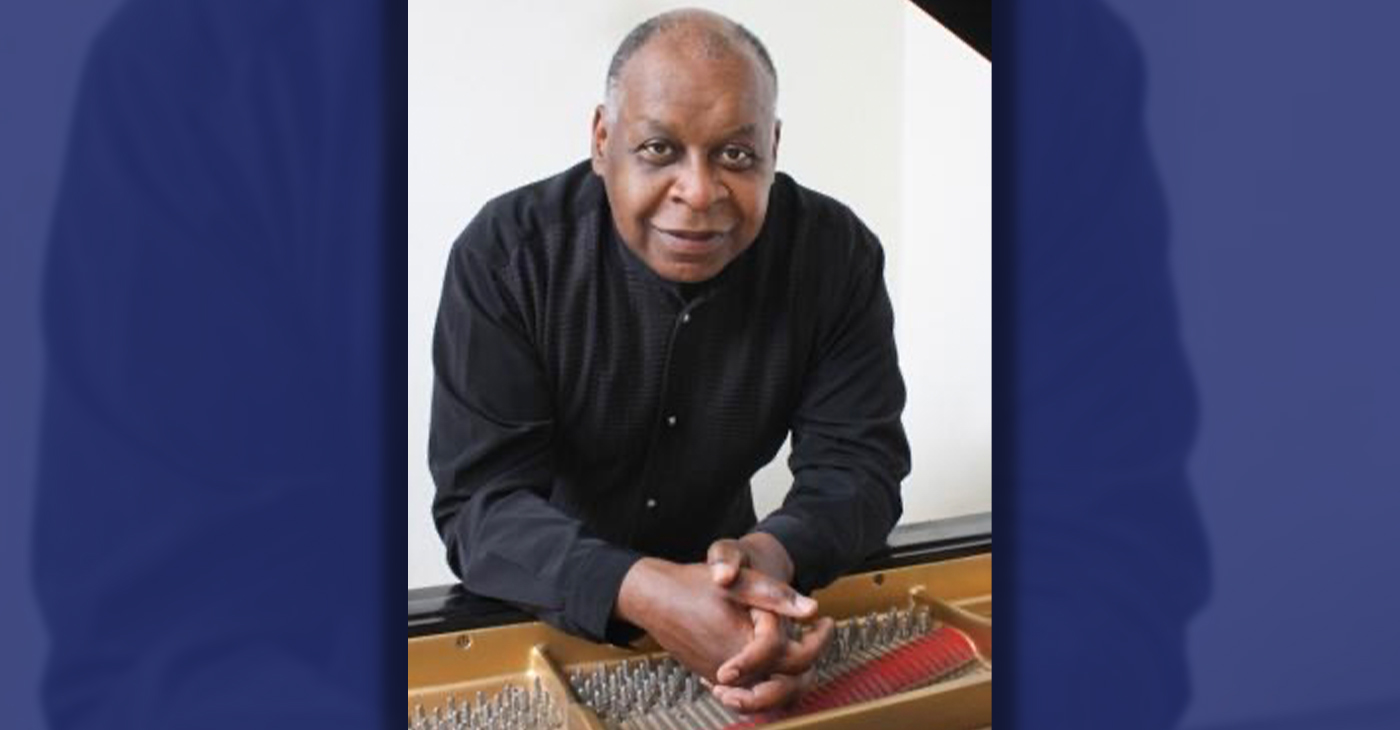
By Barbara Fluhrer
Born in Liberty, Missouri, Carl Blake, a virtuoso and respected pianist, made his most recent migration to the East Bay in 1999.
One might have seen him performing recently at Noontime Concerts in San Francisco, or at the Piedmont Center for the Arts in Oakland. He is Director of Music at The Church for the Fellowship of All Peoples in San Francisco. He was also co-organizer and collaborative pianist at Herbst Theater for The Majesty of the Spirituals concert in 2022 and has held several church positions in the Bay Area.
Blake obtained a Bachelor of Music from Boston University and continued post-baccalaureate studies in Jamaica before earning a Master of Arts in Music at San Jose State University. He was the recipient of two Fulbright residencies in Honduras and completed a third residency at the University of St. Petersburg in Russia. He has a Doctor of Musical Arts from Cornell University.
At age 19, Blake, then an undergraduate piano major at Boston University, was “discovered” by Impresario Dr. W. Hazaiah Williams, who is the Founder and Director of Today’s Artists/Four Seasons Arts.
Williams honored Blake by awarding him the first Marian Anderson Young Artist Award. Anderson personally presented the award at the Masonic Auditorium in S.F. Subsequently, Blake was presented by Dr. Williams in his San Francisco debut at The Herbst Theatre. Williams subsidized a year of study abroad for Blake at the Paris Conservatory of Music. Additionally, Williams sponsored Blake’s New York Weill Hall debut, where he has performed twice since. Blake performed several times at the Yachats Music Festival in Oregon.
Blake continues to perform nationally and abroad. His hobbies are reading, baking and travel. He says, “I’m still pumping ivories, as Belgian pianist Jeanne Stark described the disciplined practice of concert piano.”
Arts and Culture
Oakland Jazz Great Offers Master Class as City Declares “John Handy Day”
World-renowned jazz master saxophonist John Handy, a McClymond’s High School graduate, was presented with a Mayor of Oakland Proclamation declaring Feb. 12, as John Handy Day in the city. Handy is most notably known as the featured saxophonist for Charles Mingus on “Goodbye Pork Pie Hat” from the album “Mingus Ah Um” (1959) and on “Hard Work” from his own album “Hard Work” (1976).

By Conway Jones
World-renowned jazz master saxophonist John Handy, a McClymond’s High School graduate, was presented with a Mayor of Oakland Proclamation declaring Feb. 12, as John Handy Day in the city.
Handy is most notably known as the featured saxophonist for Charles Mingus on “Goodbye Pork Pie Hat” from the album “Mingus Ah Um” (1959) and on “Hard Work” from his own album “Hard Work” (1976).
“John Handy is a jazz icon and an inspiration to musicians everywhere,” said Ayo Brame, a 16-year-old Oakland tenor saxophone player who is enrolled at the Oakland School for the Arts.
In celebration of this day, the reception in downtown Oakland at Geoffrey’s Inner Circle was a gathering of artists, young and old, coming together in his honor and celebrating his 91st birthday.
Handy presented a Saxophone Colossus free masterclass for musicians. This class afforded a rare opportunity to learn about the saxophone from an aficionado. The class was free and open to all – saxophonists, vocalists, aficionados, students, and casual listeners.
“As a longtime friend for over 60 years, and fellow musician who has had numerous opportunities to share the stage with John, it has always been a pleasure performing with him and hearing his creative interpretations of the music and his gift of ease inspiring the next generation of jazz musicians,” said Roger Glenn, a multi-instrumentalist.
-

 Activism4 weeks ago
Activism4 weeks agoOakland Post: Week of March 27 – April 2, 2024
-

 #NNPA BlackPress4 weeks ago
#NNPA BlackPress4 weeks agoBeloved Actor and Activist Louis Cameron Gossett Jr. Dies at 87
-
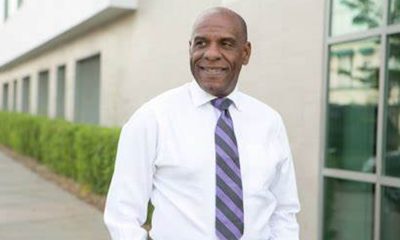
 Community1 week ago
Community1 week agoFinancial Assistance Bill for Descendants of Enslaved Persons to Help Them Purchase, Own, or Maintain a Home
-

 Activism3 weeks ago
Activism3 weeks agoOakland Post: Week of April 3 – 6, 2024
-

 Business1 week ago
Business1 week agoV.P. Kamala Harris: Americans With Criminal Records Will Soon Be Eligible for SBA Loans
-
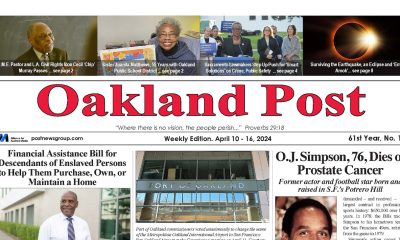
 Activism2 weeks ago
Activism2 weeks agoOakland Post: Week of April 10 – 16, 2024
-

 Community1 week ago
Community1 week agoAG Bonta Says Oakland School Leaders Should Comply with State Laws to Avoid ‘Disparate Harm’ When Closing or Merging Schools
-
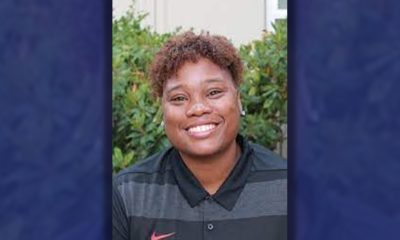
 Community6 days ago
Community6 days agoOakland WNBA Player to be Inducted Into Hall of Fame


